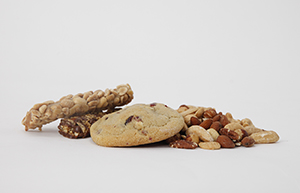When Your Child Has a Food Allergy: Tree Nut

When a child has a tree nut allergy, coming into contact with even small amounts of tree nuts can cause a life-threatening reaction. For that reason, your child must stay away from tree nuts and any foods that contain them. This sheet tells you more about your child’s tree nut allergy. You’ll learn what foods your child should stay away from, what to look for on food labels, and how to prevent cross contact. Cross-contact means that tree nuts accidentally come in contact with foods your child can safely eat.
Foods to stay away from
All true nuts, such as almonds and walnuts, grow on trees. Peanuts are a legume and grow underground. Yet many children who are allergic to tree nuts are also allergic to peanuts. Ask your child’s healthcare provider whether peanuts are safe for your child. Children with tree nut allergies should stay away from all of the following:
-
Almonds
-
Beechnut
-
Brazil nuts
-
Butternut
-
Cashews
-
Chestnuts
-
Chinquapin nut
-
Coconut
-
Filberts (also known as hazelnuts or cobnuts)
-
Hickory nuts
-
Macadamia nuts
-
Pecans
-
Pine nuts (also called piñon nuts, pignolias, pignon nuts, pignolia nuts, Indian nuts)
-
Pistachios
-
Walnuts
-
Almond extract
-
Any desserts that contain nuts, including cakes, candy, cookies, and pies
-
Artificial nuts that contain nut flavoring
-
Some barbecue sauces
-
Some chocolate candies. These may have had contact with nuts.
-
Cold-pressed, expeller-pressed, or virgin nut oils. Ask your child’s healthcare provider if refined nut oils are safe.
-
Energy, health, and breakfast bars that contain nuts
-
Fish and chicken crusted with nuts
-
Natural and artificial flavorings that contain nuts
-
Granolas, muesli, and other fruit-and-nut breakfast cereals
-
Mango seed. The seed of the mango (or the pit, which isn't eaten) is similar to cashews and should be avoided. The fruit is usually safe to eat. If your child is allergic to cashews, ask their provider if mangos are safe.
-
Mortadella. This is an Italian smoked sausage often made with pistachios.
-
Nut butters, such as almond and cashew butter
-
Pesto is an Italian sauce that usually contains nuts.
-
Shelled pumpkin seeds and sunflower seeds. These may be processed on the same equipment as nuts. If they're made on dedicated nut-free equipment, they should be safe to eat.
-
Specialty cheese spreads
-
Sweets, such as almond paste, marzipan, nougat, and gianduja
-
Nut milk (almond or cashew)
Note: Talk with your child's healthcare provider about the need to stay away from peanuts.
What to look for on labels
U.S. manufacturers of packaged food items must state clearly on the label if the item contains tree nuts.
Always read the entire ingredient label to look for tree nuts. These ingredients may be within the list of the ingredients. Or tree nuts could be listed in a “contains" statement under the list of ingredients. Labels may say "tree nut" and should list the specific nut.
Foods your child can safely eat may come in contact with nuts during processing. This happens most often with cookies, candy, ice cream, and dried soup mixes. Some children are more sensitive to tree nuts than others. Ask your child's healthcare provider about foods that carry these warnings:
-
May contain traces of nuts.
-
Made in a factory that processes tree nuts.
-
Produced on equipment shared with tree nuts.
Always use caution with imported foods, especially chocolates. They may contain allergens not listed on the label.
Nonfood allergens to watch for
Many nonfood products contain tree nuts or tree nut oils. These nonfood items are not regulated by the FDA. These include:
-
Over-the-counter medicines and supplements
-
Toys and crafts, such as hacky sacks and beanbags
-
Pet food, such as hamster, gerbil, and bird food
-
Suntan lotions, shampoos, soaps, bath oils, body oils, and skin creams. If you’re not sure about a product, visit the product maker’s website or call the toll-free number on the package.
Preventing accidental exposure
Foods your child can safely eat may come in contact with tree nuts at home, at school, and in restaurants. To help prevent accidental exposure:
-
Always have 2 epinephrine auto-injectors with your child. Make sure you and those close to your child know how to use it.
-
Have your child wear a medical alert bracelet or necklace with their allergy information.
-
Teach your child not to eat snacks that are given outside the home. Your child should also not sample free cookies and other snacks in stores or buy candy from vending machines.
-
Don’t grind nuts in a grinder you use for other foods. If you chop nuts, thoroughly wash cutting boards and knives before using them again.
-
Don't use the same scoop for different ice creams.
-
Explain your child’s allergy to your child’s teacher and other parents.
-
Talk to your child’s school about having a nut-free table in the cafeteria.
-
Send nut-free treats to school and to parties and outings.
-
Be careful around salad bars and buffets, especially in Asian restaurants.
-
Carry a chef card that explains your child’s allergy to restaurant workers. You can make your own card or print one from a website on the Internet.
Call 911
If your child has any of the symptoms listed below, act quickly. Use an epinephrine auto-injector right away if one has been prescribed. Then call 911.
-
Trouble breathing or cough that won’t stop
-
Swelling of the face and mouth
-
Vomiting or severe diarrhea
-
Dizziness or fainting
Many areas of ongoing research focus on understanding allergies and allergic reaction. Please check with your child's healthcare provider about new research findings that may help your child.